In response to critics of supernatural horror tales, H.P. Lovecraft commenced his now famous work of literature with this incisive reply:
The appeal of the spectrally macabre is generally narrow because it demands from the reader a certain degree of imagination and a capacity for detachment from everyday life. Relatively few are free enough from the spell of the daily routine to respond to tappings from outside, and tales of ordinary feelings and events, or of common sentimental distortions of such feelings and events, will always take first place in the taste of the majority... ([1927] 1973 : 12).
Reformulated nowadays, Lovecraft might as easily have suggested that the appeal of the spectrally macabre demands that one plays its game. Because, while it is true that all genres are characterized by a set of pre-established conventions that generate a certain number of more or less precise expectations stimulating a certain reflexive game of guesswork and recognition, the horror genre might be the one that has been most often compared to a game.
Dealing with the industrialization of fear, Ruth Amossy has notably stated that the «art to frighten» is openly presented as a ludic activity, its stereotypes being direction signs that «announce at the entry and at critical points of the fictional terror: “All those that enter here accept to surrender to the dizziness of fear”» (Amossy, 1991: 142, freely translated). Many film scholars have made references to a game analogy in order to explain contemporary horror cinema. Vera Dika has shown in Games of Terror how the Stalker film formula of the 80’s placed the spectator in a condition «less like watching a tennis match, for example, than like playing a video game» because it involves an interaction with both the narrative and the formal elements (1990: 22). In Planks of Reason: Essays on the Horror Film, Morris Dickstein emphasized that «the main point of a horror film is to frighten us or rather to play on our fears (1984: 65, underlined by the author), whereas Dennis Giles explained that certain «viewers displace themselves from the fiction by laughter, intentionally misreading the emotional cues of the text, refusing to play by the rules of its game» (1984: 41).
Insofar as the contemporary horror film was already playful and “interactive”, it was then just a short step to remediate cinematic conventions and effects, and to make horror video games. Looking at it from this perspective, the survival horror genre might be the game genre most often compared to film. From Resident Evil (Capcom/Capcom, 1996) to Resident Evil 4 (Capcom/Capcom, 2005), the «challenging cinematic gameplay» (RE1) and the «game’s movielike feel» (RE4) have been for example underlined by the Gamespot.com’s reviewers. It is as a «cinematic horror experience» (box sets of SH1, 1999 and SH2, 2001) that the Silent Hill series (Konami/Konami) has been advertised. Speaking of these two series, Steven Poole reasoned:
Why is it particularly the horror genre, and to a lesser extent science-fiction, that largely provides the aesthetic compost for supposedly “filmlike” videogames? (....) The answer is that horror genre can easily do away with character and plot; it is the detail of the monster, the rhythm of the tension and shocks that matter. Plot and characters are things videogames find very difficult to deal with (2000 : 79).
Indeed, the connection between horror film and game remains obvious. It’s for this reason that one has to acknowledge yet again their similarities and differences to better expose the specificity of the video game which, to agree with Tanya Krzywinska’s contention, «is organised to intensify and extend the types of emotional and affective experiences offered by the horror film» (2002 : 207).
It’s worth stating from the outset that in spite of the detail of its monsters, its tension and its shocks, horror video games do not have much to do with “horror” itself. In fact, like Steven Jay Schneider rather relevantly observed in «Toward an Aesthetics of Cinematic Horror», a small number of contemporary films (post-1960) actually succeeded in horrifying entire audiences. Schneider quotes philosopher Robert C. Solomon explaining that «horror “is an extremely unpleasant and even traumatizing emotional experience which renders the subject/victim helpless and violates his or her most rudimentary expectations about the world”» (2004 : 135). Horror, as opposed to fear, is a spectator emotion that sees one aghast [1]. Although extreme graphic violence does not guarantee to qualify images as horrifying, it remains true that the 3-D design of games lacks the photorealism of cinema. It lacks the that-has-been (ça-a-été) which is the essence of photography for Barthes (1980) and which would place us in a pure spectator position [2]. Even the few interactive horror movies have never reached this essence as their video pixilation and/or the actors in front of obviously rendered backgrounds were creating a certain distanciation, distanciation manifest in current 3-D imagery. There might be some revolting moments, such as a woman’s slaughter by means of a spade to the mouth in Chapter Four of Phantasmagoria (Sierra/Sierra, 1995) [Figure 1], but not horrifying ones [3].
Phantasmagoria (Sierra/Sierra, 1995)
Figure 1
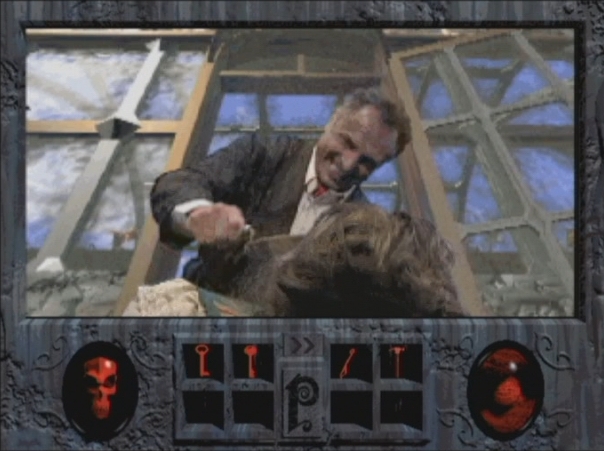
What horror video games — labelled survival or not — actually offer is similar to what the mainstream contemporary horror cinema proffers. To refer to the well-known expression of Isabel Pinedo, it’s a «bounded experience of fear» (1996 : 25 and 2004 : 106). This bounded dimension explains in part the famous paradox of horror. According to Pinedo:
Horror is an exercise in recreational terror, a simulation of danger not unlike a roller coaster ride. Like the latter, people in a confined space are kept off-balance through the use of suspense and precipitous surprises achieved by alternating between seeing what lies ahead and being in the dark (for instance, tunnels and other shadowy regions, closed and shielded eyes).Throughout, the element of control, the conviction that there is nothing to be afraid of, turns stress/arousal (beating heart, dry mouth, panic grip) into a pleasure sensation. Fear and pleasure commingle (2004 : 106).
Pinedo further notes that although the violation and death of the body is only experienced partially, although the danger fails to materialize, we fear the threat of physical danger. «The experience of terror is bounded by the tension between proximity and distance, reality and illusion» (2004 : 107). In Caillois’s ludic terms, we would say that we are aware of the second reality and freely devote ourselves to it. In Murray’s terms, we would emphasize that we are actively creating beliefs. For instance, we’ve all seen a horror movie scene like the one at the beginning of The Grudge (Takashi Shimizu, 2004): in a house that suddenly gives you the creeps, a young and innocent nurse hears odd sounds coming from the dark attic. Even if she is on her own, in a place she does not know and only has a lighter to guide her later on, the nurse decides to go investigating. If we are questioning why she chooses not to flee, then we displace ourselves from the fiction, and the effects of the scene will be lost. But as horror spectators we are willing to properly read the emotional cues of the text. Even if we are seated in a theatre, feeling safety in numbers, we choose to go along with the character - who is going to move forward in any case (we are in a ride!) - and become scared. A similar scene will not play on our fears in the same way as in the case of a single player game where we are sitting playing alone in the dark. Since we are in control of our avatar (or point of view), the analogy with the old haunted house that one has to walk-through - as opposed to those where we are seated in a doom buggy - obviously better suits the horror video game than the relentless forward ride of a roller coaster [4]. Even if we follow a path, we are made to feel that we are actively exploring a place. We could choose to make a bolt for it, but that would not bring us far in the game and sometimes it’s not even an option, sometimes there is no escape, for example when the avatar is locked in a room with no obvious way out. Although we might judge the film character’s curiosity, in playing the game we are required to be inquisitive, in so far as there might be a key, an item or a door where the odd sound is emanating from [5]. That’s what’s happening continuously in the Silent Hill series which is filled with eerie, growling and shrieking sounds that make us hesitate before moving forward. But we remain aware that we are in a game, actively playing it. That is why it is essential to nuance the reflection in the March 2005 issue of the Edge magazine about «Scare Tactics»:
Games that want to capitalise on their ability to hurt you in the real world can only do it by threatening loss of progress and repetition, and that repetition invariability dulls the fright of the horror that the game has in store for you. It’s an issue that undermines many of the most successful frighteners ever made. Fatal Frame 2, from the moment the first ghost hand slips on to Mio’s shoulder, does a master job of creating a sickening, threatening world. But the moment you become more concerned about finding a save point than finding your sister, all that atmospheric effort becomes irrelevant. Replaying sections of Doom 3 has all the terror of a fairground duck shoot as you wait for zombies to shamble into place. All too often, the interactivity of games can undermine their scariness, rather then enhance it (Editorial team, 2005: 70).
Ringu-evil-killer-types of videotape, we must acknowledge, exists only in fiction. If danger was to actually materialise, there would certainly be less gamers of the night. Nevertheless, the play-mood is labile in its very nature (Huizinga). A game can bore us or frustrate us. We can perceive it only as a map or a system, and only think about «gameplay consequences». Pure repetition or discovered algorithms indeed destroy the frightening moments, not even transforming surprise into suspense. But again, more than any other genre, horror is an experiential route [6] best lived in the course of its first walk-through. Besides, horror video games are mainly story-driven ones. As long as we’re caught up in the experience, it does not really change anything to find as in Clock Tower 3 (Sunsoft/Capcom, 2003) a place to hide from a stalker [Figure 2], a place that will enable us to overpower or distract the aforementioned monster in order to escape from it [Figure 3], or a point to save our game (or to refill the bottle of Holy Water) [Figure 4].
Clock Tower 3 (Sunsoft/Capcom, 2003)
Figures 2 - 3 - 4
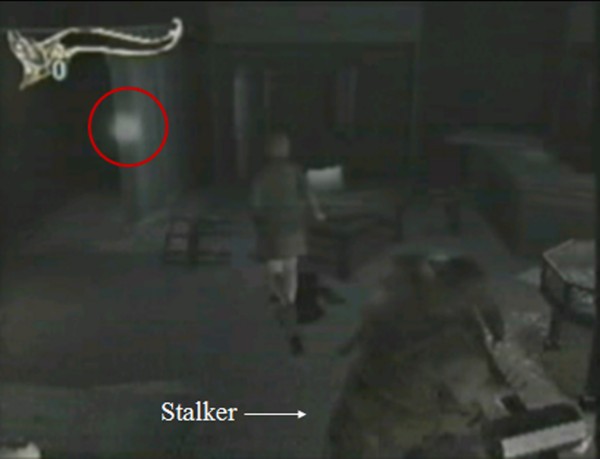 |
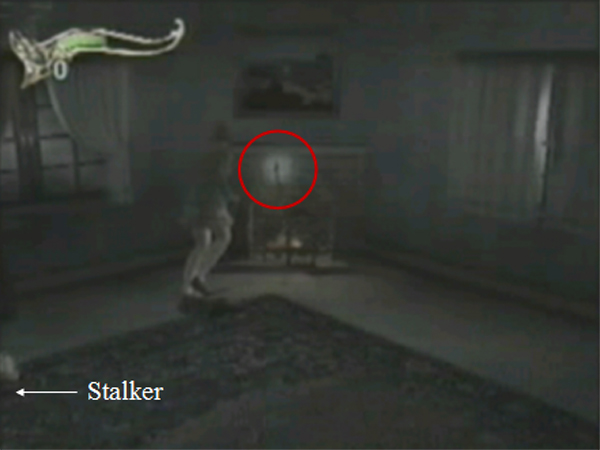 |
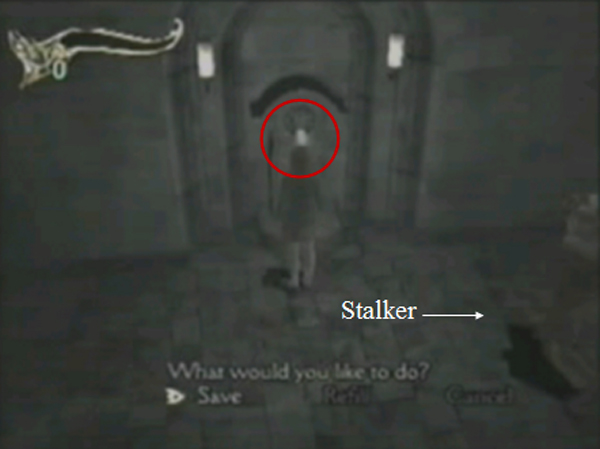 |
While the first two places and actions are associated to the second reality
of the game-world (intradiegetic) and the third one more related to the
first reality of playing a game (extradiegetic), they all bring a great
relief upon our nightmarish journey [7].
The paradox of horror also depends upon the fact that ludic fright elicits real fear. We will startle, as we’ve all experienced, upon a sudden burst whether it be in real life, in a film or in a game. Everyone who has played Resident Evil (1996) remembers the effect of the dogs bursting through windows while we are crossing a corridor at the beginning of the game. In addition, like Scissorman’s sudden blow to the security guard just before the heroine Jennifer Simpson goes back into the university research building [Figure 5], few cinematics of Clock Tower (Human Corporation/ASCII Entertainment, 1997) are still very effective today.
Clock Tower (Human Corporation/ASCII Entertainment, 1997)
Figure 5
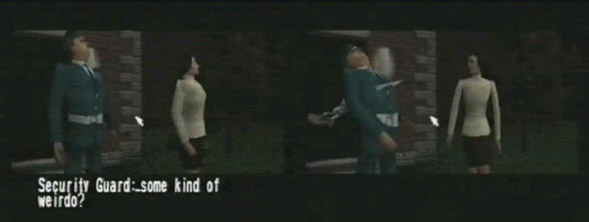
However that may be, our real reactions are not merely automatic responses. As far as cognition and emotion work together, fear and its physiological responses (changes in heart rate, respiration, skin temperature, hand moistness, muscular tension, etc.) depend on the ways a real or a fictive situation is appraised. Noël Carroll has quite pertinently shown in his famous thought theory of emotional responses to fiction how those responses do «not require the beliefs that the things that move us be actual. We can be moved by prospects that we imagine» (1990 : 88). We are returning here to Lovecraft’s opening quotation. Fear is broadly conceived as a negative emotion related to the perception of a threat. When we become aware of a danger, we are knocked off-balance. We start to anticipate what could happen next and to begin to dread that the threat might materialize itself. It might finally be when we are afraid that we are telling ourselves the greatest short scary stories. At the moment we hear odd sounds coming from the attic at the beginning of The Grudge, we start to imagine what might happen to the young nurse. Our fear is rooted in the fictional world and is linked to the nurse’s behaviour. But as I have explained elsewhere (Perron, 2005), the emotional experience of games does not revolve around those kinds of fiction and witness emotions. We are playing games for gameplay emotions, emotions arising from our actions in the game-world and the consequent reactions of the game(-world). Fear is in that sense a very suitable gameplay emotion.
Emotions are action tendencies. They prompt us to establish, maintain, or disrupt a relationship with the environment. To refer once more to Solomon as quoted by Schneider, fear is not the same thing as horror. Fear has an action-orienting quality that the latter spectator emotion is missing. While the “gawking impulse” of horror leads us to contemplation or fixation, there is an inherent urge to act when we are scared (Schneider, 2004 : 140). Fear is by and large manifested by the impulse to move, to run away. On the one hand, fear has a strong action tendency because it is clearly object-oriented. We might not agree with the overall relevance of Carroll’s art-horror definition since it does not deem fear as central to the horror genre, but it is easy to accept his focus in regards to horror video games. Because, from encounters with «giant hairy tarantulas, vampire bats and menacing ghost» (Atari’s Haunted House box set) to battles with «Host of Evil Ghouls and Terrifying Spirits» (Clock Tower 3 box set) or with «creatures that defy the laws of nature» (Resident Evil 4 box set) [Figure 6], from the «more ghastly apparitions to vanquish» (Fatal Frame 2 box set) [Figure 7] to the not to be ignored boss confrontations, the figure of the monster is at the core of the videoludic experience of fright.
Resident Evil 4 (Capcom/Capcom, 2005)
Figure 6
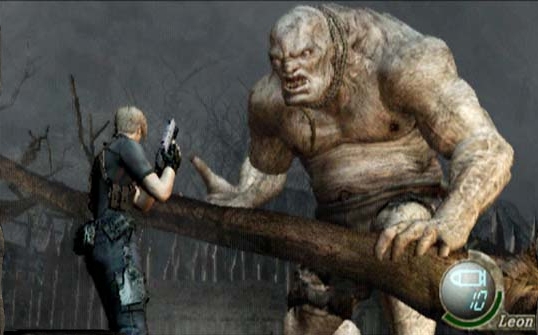
Fatal Frame 2 (Tecmo/Tecmo, 2003)
Figure 7

Designed as disgusting entities, the monsters of horror video games are dangerous. On the action level, they are physically threatening because they are lethal and have the power to maim and to kill. On the narrative level, they become psychological, moral or social menaces by their attempt to destroy one’s identity and moral order. Horror video games ask for cognitive engagement, in order to, in Carroll’s terms, discover those impure, disgusting and scary monsters, and imaginative engagement to speculate about what they might be like and how they might be managed and destroyed [8]. On the other hand, fear is goal-oriented. Afraid, we want to disrupt the relationship with the monsters. In that sense, horror video games can be seen as a mutated form of recreational terror, a form where the simulation of danger, stressed by Pinedo, has evolved so as to become increasingly genuine. We do not feel fear by empathizing with a character as we do in film, and as we did in interactive horror movies. Once we’ve pointed-and-clicked on the haunted bed in the first chapter of Phantasmagoria for example, we couldn’t try to make Adrienne escape the hands that were suddenly grabbing her. We could only watch until the end of the sequence. But if we could have been in command of our avatar, we would have experienced the action on a personal level as we do with game real-time controls. Games are simulation, not representation. Following Frasca : «Simulation does not simply retain the - generally audiovisual - characteristics of the object but it also includes a model of its behaviours. This model reacts to certain stimuli (input data, pushing buttons, joystick movements), according to a set of conditions» (Frasca, 2003 : 223). Regarding behaviours, horror video games draw upon the psychology of fear:
[L]imiting ourselves to the most general statement possible, we may say that a frightened animal is most likely to try one of the three F’s - freezing (keeping absolutely still and silent), flight, or fight - when he is faced with a punishment or the threat of a punishment; or he may learn something quite new which will terminate the danger to keep him out of the dangerous situation in the future. That most interesting of the animals, Man, behaves in much the same way (Gray, 1971 : 10).
We are indeed likely to try the three F’s in games. The most important thing is that we have a choice. It’s our perception of the threat and our coping potentials that determine the intensity of our fear and how we’ll respond. That’s why videogames «simulate emotions in a form that is closer to typical real life experiences than film» (Grodal, 2000 : 201). Depending upon the weapons we have at hand, on the supply of ammunition or the amount of health in reserve, and on the game controls (for instance, we can shoot and run at the same time in The Suffering, but not in Resident Evil 4), we may flee in a zigzag to avoid being attacked, stand still to let the danger pass, slowly bypass unnecessary confrontations, charge the enemies or circle around them while fighting, etc.
If the horror film is as much an exercise in terror as «an exercise in mastery, in which controlled loss substitutes for loss of control» (Pinedo, 1996 : 26), this latter exercise takes a practical dimension in games. It leads to yet another paradox : the paradox of control. Following Csikszentmihalyi’s flow theory, Salen and Zimmerman describe it this way : «In an optimal experience, the participant is able to exercise control without completely being in control of the situation» (2004 : 337). For instance, Clock Tower 3 and Eternal Darkness: Sanity’s Requiem (Silicon Knights/Nintendo, 2002) have explicitly incorporated this dialectic in their gameplay. In the former, there is a Panic Meter visible at the upper left corner of the screen [9]. When Alyssa is getting scared, this meter rises and Alyssa begins to act more and more erratically. Running in every direction or stumbling around, she becomes hard to control. It even comes to a point where she is not responding to our commands anymore, freezing for example in fright in front of the lethal monster [Figure 8].
Clock Tower 3 (Sunsoft/Capcom, 2003)
Figure 8
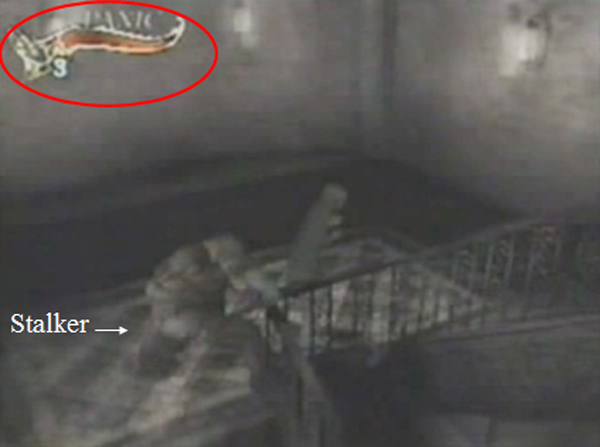
It’s by hiding and by escaping from the monster that Alyssa will calm down. Clock Tower 3 puts into play - met en jeu - the off-balance of fear. It shows how it is not easy to master our (avatar’s) loss of control. Eternal Darkness: Sanity’s Requiem is known as «the first example of a game that plays the player» (Gamespot.com). In that sense, the game stands at the limit of the temporary world it creates and the ordinary world where it is played. It possesses a Sanity Meter visible on the inventory screen. This meter decreases every time we encounter a monster. Once it falls very low, it makes weird things happened to our avatars, game-world, television set and console (i.e. : sounds of someone being tortured in another room, room where we enter is upside-down, our avatar turns into a zombie, we have a “disk error”, etc.). It is effectively quite scary - especially in the middle of the night - to see that while we are saving our progress after many hours of play, our operation leads to the erasing of our saved games, and not the inverse. Personally, during “A Journey into Darkness”, I wondered for moment - even after the end of my game session - if I had made Edwin Lindsey shoot directly at the screen accidentally, leaving buckshot holes, or if it was really an insanity effect triggered by the game system as the result of my action. I was made to lose control of myself [Figure 9].
Eternal Darkness: Sanity’s Requiem (Silicon Knights/Nintendo, 2002)
Figure 9
As I have shown, studying the effects of forewarning systems in the survival horror genre and the way the tension of suspense was as central to the experience as the shock of surprise (Perron, 2004), horror video games make great use of the notion of uncertainty, a key component of games. With its creepy atmosphere creating a fearful mood that encourages and prepares us to experience fright, the horror video game once again refines the effects of what Pascal Bonitzer has called “blind space” (1982). The screen being a mask, our vision remains partial. If the vision is partial, «the enemy is virtually everywhere» (1982 : 96). While cinema «implicates that which is happening in the contiguity of the off-screen space, it has as much importance, from a dramatic point of view - and sometimes even more -, than what is happening inside the frame» (Bonitzer, 1984 : 97, freely translated), the entire visual field of the video game is much more dramatised because we can and have to walk-through this off-screen space. Indeed, the videoludic art of fright revolves in great part around the blind space. Everyone remembers the first long fanged monster breaking through the window on a sudden music chord in order to attack us in the attic at the beginning of Alone in the Dark (I-Motion Inc. & Infogrames/Interplay, 1992). But there is a more effective and representative scene of the genre to come once we go downstairs to the room where we find Hartwood’s diary about Decerto’s malediction. If we walk into the room and go directly to the diary, a long fanged monster suddenly enters by the left side of the frame and attacks us [Figure 10]. But if we further penetrate into the room when we walk in - bringing a new camera angle - and investigate the window, we hear a scary growl behind the curtain, but nothing will happen [Figure 11].
Alone in the Dark (I-Motion Inc. & Infogrames/Interplay, 1992)
Figures 10 - 11
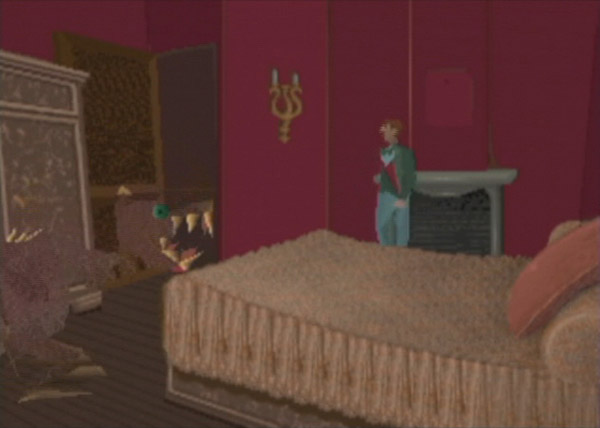 |
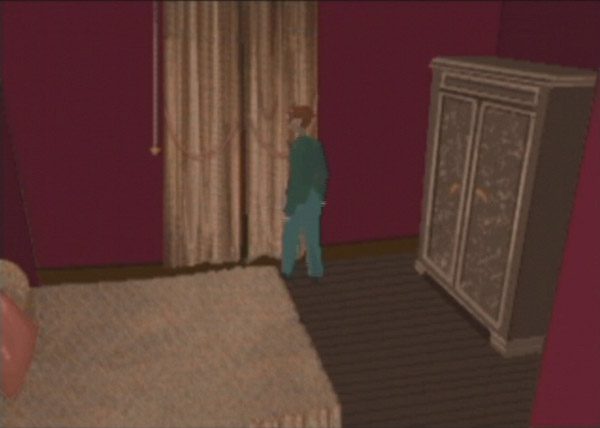 |
It is only when we return to the first frame of the diary that we’ll be attacked. The monster is meant to be lurking in the blind space, sometimes very close for a surprising attack. The cinematic fixed camera angles of the Alone in the Dark series which have been exploited in the Resident Evil series - and in many other games - obstructs us intentionally from seeing what danger lies ahead. Although Resident Evil 4 is introducing moving camera view and is enabling us to adjust the angle, the zoom view behind Leon’s shoulder when he is aiming and shooting reduces our field of vision and makes us less aware of what’s around. Much more clever than zombies, the enemies are actually coming from everywhere in the game-world and it is hard to “disrupt the relationship”. This is the case for instance in our first visit to Pueblo in Chapter One or during the enemies’ assault in the barricade cabin of Chapter Two. It is terrifying and panic-inducing to realize that the foes keep coming at us. But at least, we are not in complete darkness. Because, as fear of the dark is one of our primary frights, horror video games also render our vision partial inside the frame by playing with lighting. Atari’s Haunted House (1981) gave the adventure its first pitch-black representation. The reddish diamond-form view representing the lighting of matches around the pair of eyes - our avatar - made the search for three pieces of a magic urn and the master key more difficult and the bumping into monsters less inevitable. Working differently as a FPS, Doom 3 (id Software/Activision, 2004) dramatizes its 3-D navigable by asking us to choose between a flashlight and a gun. Its Mars research facility is a labyrinth among others, full of dark corners that might at first glance be taken for walls, but from which monsters can spring [Figure 12].
Doom 3 (id Software/Activision, 2004)
Figure 12

Therefore, holding the flashlight enables us to spot the corners but leaves us defenceless, while gripping the gun gives us protection but allows for less or even no time for response - from which the numerous startle effects. However, it is certainly the Silent Hill and the Fatal Frame series that have best exploited the relation between darkness and blind space. In Fatal Frame, the notion of space is itself altered since the ghosts we fight with our camera are translucent incorporeal entities that can pass through walls and closed doors. While Fatal Frame also draws upon the device, Silent Hill might offer the best use of the flashlight. Since we can almost only see what we light in the first three games of the series, we have to be more careful, because monsters can not only be waiting beyond the limits of the frame, but also just outside the real-time light halo [Figure 13].
Silent Hill 2 (Konami/Konami, 2001)
Figure 13
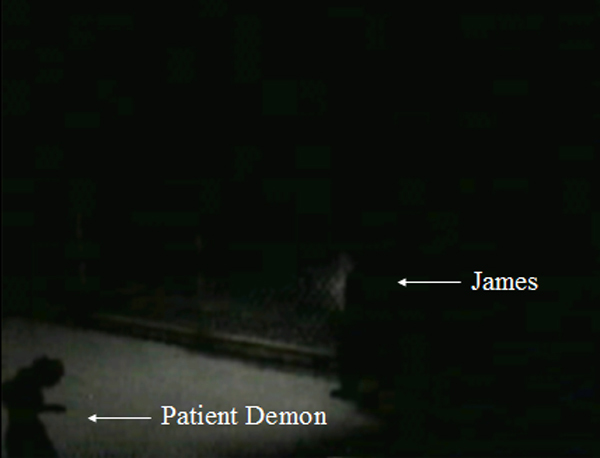
What’s more, monsters are even scarier with their appearances greatly increased by their big and distorted body silhouetted on the floors and walls [Figure 14].
Silent Hill 3 (Konami/Konami, 2003)
Figure 14
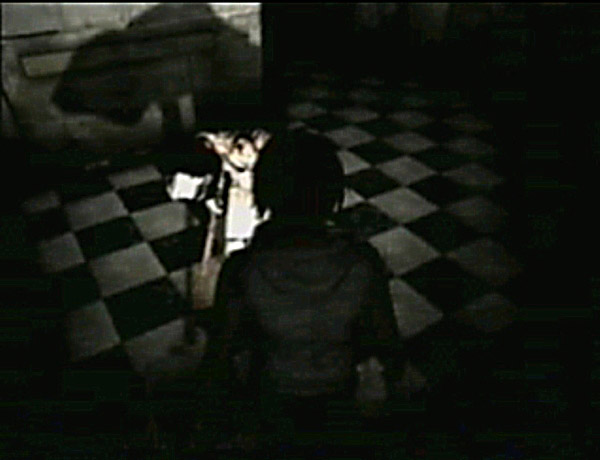
Silent Hill has also a great forewarning system in the pocket radio that transmits only white noise when there are enemies nearby. Just as good scary film relies a lot on the audio, one should not forget that the visual blind space is couple with a hearing space, perhaps less partial but very variable and much more imprecise [10]. Not knowing exactly from where the threat will come from and what it will be like as the static grows louder, we imagine the worst and stay on our guard until we encounter or escape the source of the emission.
Morris Dickstein wrote in «The Aesthetics of Fright»: «Getting caught up emotionally, walking out drained and satisfied, waking up relieved to deal with workaday problems - this is the secret of horror films (1984 : 77). Well, the video game has also found this secret, making our «bounded experience of fear» more intense. Horror video games, and I made this comment about the Silent Hill series, are fiendishly designed to scare us. But in so far as the horror genre asks for imagination, that fear depends on our perception of a threat and our coping potentials, and that the simulation of danger draws on the psychology of the aforementioned emotion, horror video games are nothing else than Haunted Houses, playgrounds where we come to play at frightening ourselves.
ACKNOWLEDGMENTS
I wish to thank Shanly Dixon for her proofreading and suggestions and
Eugenie Shinkle for sending the Edge magazine’s articles.
NOTES [
back ]
[1] Just think of how terrorist acts reported and/or shown live in the
news leave us aghast, horrified.
[2] The has-been-there might be the whole point of snuff movies.
[3] Quite apart from the fact that the gamer could have played a censured
version.
[4] Besides, from Atari’s Haunted House (1981) to The
Suffering (Surreal Software/Midway, 2004), mansions, prisons, schools,
hospitals, villages or cities visited by ghosts, evil spirits and dangerous
creatures are common places in the video game.
[5] Like Krzywinska underlines : «Unlike that of the horror films,
the operation of the moral occult in videogames is rarely oriented around
the punishment of curiosity. (…) In games, therefore, space is something
to be actively, physically, investigated if the player is to beat the
game. (…) What is “punished” in videogames is not so
much curiosity, as in the horror film, but the failure to make it to the
next scene» (2002: 217).
[6] I’m making reference here to Grodal’s distinction between
the «game as an experiential route» and the «game as
a map and as a system». But one does not need to see those poles
as totally opposite as they both can bring their own pleasures (2003 :
144).
[7] As the rest of my argument will show, this assertion of the Edge
magazine is also to be questioned: «Just what it is that shoots
through you when Yoshi loses hold of Mario in Yoshi’s Island?
It makes your heart pound and your palms flash with sweat, no question.
Mario’s desperate bleats assault your ears as all your skills desert
you in your desperate flounderings to recover him. But just what is it
you’re feeling? Panic? Certainly. Anxiety? Sure. Guilt? A little
bit. But fear? Not really. Face off with a boss in Devil May Cry
and you’re likely to swallow a gulp. You’re daunted by his
size, nervous about your performance, dread-filled at the prospect of
repeated defeats. Scared? Not so’s you’d notice» (Editorial
team, 2005 : 71). Well, Mario Bros. games are not horror games
and are not meant to be scary. Mario Bros. is not Castelvania.
Then, isn’t it odd to think that we could feel regret for Mario
as regret is an emotion elicited when one cannot redo something, and not
be scared in the underworld of Devil May Cry where the object
of fear and the goal are patent?
[8] The cognitive engagement refers to Noël Carroll’s curiosity
theory about horror and the imaginative engagement to the critic of the
work of Carroll by Mark Vorobej in «Monsters and the Paradox of
Horror» (1997).
[9] There was also a Panic Mode in the first two Clock Tower
games, but it was less effective in those point-and-click adventure games.
This device is also used in Haunting Ground (Capcom/Capcom, 2005).
[10] As my colleague Serge Cardinal, a film sound specialist, pointed
out to me, the horror genre modulates sound to a great extend according
to its sources : invisible-silent/invisible-sound, or visible-silent/visible-sound.
This allows for the creation of surprise or of suspense.
REFERENCES
Amossy, Ruth (1991). «L’industrialisation de la peur», Les Idées reçues. Sémiologie du stéréotype, Paris : Nathan, p. 121-142.
Barthes, Roland (1980). La chambre claire. Note sur la photographie, Paris : Cahiers du cinéma, Gallimard and Seuil.
Bonitzer, Pascal (1982). Le champ aveugle. Essais sur le cinéma, Paris : Cahiers du cinéma and Gallimard.
Caillois, Roger ([1958] 1961). Man, Play, and Games. Translated by Meyer Barash. New York: The Free Press of Glencoe.
Carroll, Noël (1990). The Philosophy of Horror or Paradoxes of the Heart, New York : Routledge.
Dickstein, Morris (1984). «The Aesthetics of Fright», in Barry Keith Grant (ed.), Planks of Reason: Essays on the Horror Film, Metuchen, N.J. : Scarecrow Press, p. 65-78.
Dika, Vera (1990). Games of Terror. Halloween, Friday the 13th, and the Films of the Stalker Cycle, Rutherford, New York : Fairleigh Dickson University Press.
Editorial Team (2005). «Scare Tactics. Exploring the Bloody Battleground Between Fear and Frustration», Edge (UK), No 149 (March), p. 69-73.
Frasca, Gonzalo (2003). «Simulation versus Narrative. Introduction to Ludology», in Mark J.P Wolf and Bernard Perron (eds.), The Video Game Theory Reader, New York : Routledge, p. 221-235.
Giles, Dennis (1984). «The Conditions of Pleasure in Horror Cinema», in Barry Keith Grant (ed.), Planks of Reason : Essays on the Horror Film, Metuchen, N.J. : Scarecrow Press, p. 38-54.
Gray, Jeffrey A. (1971). The Psychology of Fear and Stress, New York : McGraw-Hill Book Company.
Grodal, Torben (2003). «Stories for Eye, Ear, and Muscles: Video Games, Media, and Embodied Experiences», in Mark J.P Wolf and Bernard Perron (eds.), The Video Game Theory Reader, New York : Routledge, p. 129-155.
Grodal, Torben (2000). «Video Games and the Pleasure of Control», in D. Zillmann and P. Vorderer (eds.), Media Entertainment: The Psychology of Its Appeal, Mahwah, N.J. : Lawrence Erlbaum Associates, p. 197-213.
Huizinga, Johan ([1938] 1955). Homo Ludens. A Study of the Play Element in Culture. Boston: The Beacon Press.
Krzywinska, Tanya (2002). «Hands-on Horror», in Geoff King and Tanya Krzywinska (eds.), ScreenPlay. Cinema/videogames/interfaces, London : Wallflower, p. 206-223.
Lovecraft, Howard Phillips ([1927] 1973). Supernatural Horror in Literature, New York: Dover Publications.
Murray, Janet H (1997). Hamlet on the Holodeck: The Future of Narrative in Cyberspace, New York : The Free Press.
Perron, Bernard (2005). « A Cognitive Psychological Approach to Gameplay Emotions», DIGRA 2005 International Conference Proceedings, available online : <http://www.gamesconference.org/digra2005/papers/86d8ad01c953fad695c3549ac644.doc>.
Perron, Bernard (2004). « Sign of a Threat : The Effects of Warning Systems in Survival Horror Games», COSIGN 2004 Proceedings, Art Academy, University of Split, 2004, p. 132-141, available online : <http://www.cosignconference.org/cosign2004/papers/ Perron.pdf>.
Pinedo, Isabel Cristina (2004). «Postmodern Elements of the Contemporary Horror Film», in Stephen Prince (ed.), The Horror Film, New Brunswick : Rutgers University Press, p. 85- 117.
Pinedo, Isabel (1996). «Recreational Terror : Postmodern Elements of the Contemporary Horror Film», Journal of Film and Video, Vol 44, No 1-2 (Spring-Summer), p. 17-31.
Poole, Steven (2000). Trigger Happy: The Inner Life of Video Games. London: Fourth Estate.
Salen, Katie and Eric Zimmerman (2004), Rules of Play. Game Design Fundamentals, Cambridge, MA : MIT Press.
Schbeider, Steven Jay (2004). «Toward an Aesthetics of Cinematic Horror», in Stephen Prince (ed.), The Horror Film, New Brunswick : Rutgers University Press, p. 131-149.
Vorobej, Mark (1997). «Monsters and the Paradox of Horror», Dialogue, No 24, p. 219-249.